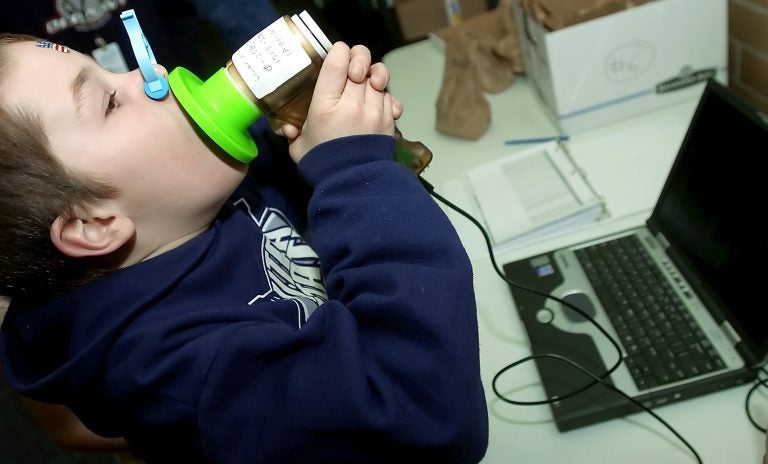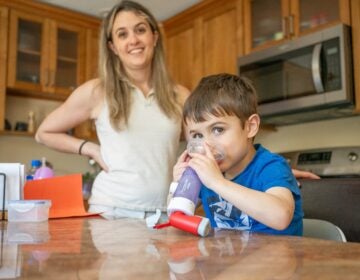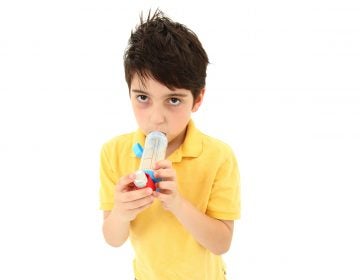Diagnosis: Allergies. But could your child have asthma instead?
It’s hard to measure lung function in children 5 and younger, but some doctors now argue there’s no excuse for not knowing for sure.

Tanner Little breathes into a spirometer that measures his lung capacity at Greenville Elementary School, Thursday, Feb. 1, 2007 in North Logan Utah. (AP Photo/The Herald Journal, Eli Lucero)
How do we help children thrive and stay healthy in today’s world? Check out our Modern Kids series for more stories.
Train wreck might politely describe any 5-year-old boy’s bedroom.
Trigger zone is another, more worrisome way, when the little boy starts to wheeze and cough from time to time.
Trigger 1. Cat fur, dusted with dander the boy breathes in regularly, covers the carpeted floor. Two small felines are the boy’s playmates.
Trigger 2. The stuffed-animal collection on the bed. Dust mites hide in plush elephant ears, soft bunny noses, goofy monkey toes, funny camel hats. Everywhere.
Trigger 3. Some mold, unknown to his parents, is growing underneath the carpet near the bed because the little guy’s nighttime cup of water gets knocked over a lot.
He develops a dry cough and a slight whistle when he breathes, two indications that his airway (the trachea, bronchi and bronchioles) leading into his lungs might be reacting to air-carried irritants. Off to see the doctor he goes.
But at the clinic, he doesn’t wheeze or cough. When the doctor asks about the home environment, his father says the boy loves his cats and always plays with his stuffed animals, which Dad concedes look battered. After an 8-minute visit — no complete family history, no chest X-ray, no conversation about whether the symptoms change with the season — the doctor suggests medication, like an antihistamine, to counter the symptoms, but not a skin test itself.
The diagnosis: allergies. Except it might be asthma instead.
About 33 percent of all asthma diagnoses start out this way: incorrectly. And it’s not just a U.S. phenomenon. Journal articles about asthma, either wrongly diagnosed or its severity miscalculated, have been written by Canadian, Dutch and Scottish researchers. Those studies were with adult patients.
With kids, “it’s probably higher,” said Sally E. Wenzel, chair of the University of Pittsburgh’s Department of Occupational and Environmental Health.
Accurately diagnosing asthma in adults typically involves measuring air flow. Either you breathe into a spirometer — basically a tube hooked up to a computer that calculates how much air you inhale and how much you exhale, as well as how quickly you exhale — or a hand-held device known as a peak flow meter that registers how well air moves out of your lungs.
A blood test can turn up signs that inflammation is at play in the airway, a huge indicator of asthma — and it’s a lot easier to do one than a skin test for allergies, said asthma researcher Barbara Yawn, a physician and adjunct professor in the Department of Family and Community Health at the University of Minnesota.
So if there are tools to help make evidence-based asthma diagnoses, why are there so many mistakes?
For one thing, there are different types of asthma — they originate in different ways, so different medications will work well with one kind and maybe not with another. And there are different levels of severity. And people who have asthma can react to the same things as those who are allergic, say, to cat dander, Wenzel said — it’s how the body responds that’s the key.
Plus, even though two people might have the same type of asthma, they may not respond in the same way to the same medication, depending on how old they were when they developed the condition. Some people get it later in life — and adult asthma is not children’s asthma.
“Kids are unique, they are not small adults,” said Reynold Panettieri Jr., vice chancellor at the Rutgers Institute for Translational Medicine. “They have different metabolism than adults. And they struggle to do airflow spirometry.”
In the 5-and-younger set, getting objective lung measures — for shortness of breath or reactions to viruses that can cause wheezing — is a real challenge, said Kurtis Elward, a family physician in Charlottesville, Va. and a member of the 2007 NIH Asthma Guideline Implementation Panel. It can make diagnosis “very, very difficult.”
For these children, breathing lots of air in and then letting it all out takes real effort and coordination, medical experts agreed. So there is little data showing what medications work on kids.
These days, most doctors don’t get a lot of time with their patients. Sure, there are asthma guidelines, said Tyra Bryant-Stephens, a physician who founded Children’s Hospital of Philadelphia’s Community Asthma Prevention Program more than two decades ago. But doctors have to choose how to spend the few minutes available, and they focus on diagnosis and treatment. They often don’t have the time to spend on education, either.
Not to mention that asthma can resemble so many other diseases.
Viruses, for example. Wheezing caused “by a virus can last for months,” Panettieri said. A virus also can cause chest discomfort and problems breathing when exercising.
“As the virus is cleared, wheezing resolves. [So the] observation by parents, the pediatrician, is [the child] had asthma but outgrew it.” That’s a myth, he said.
Diagnoses that don’t require steroids as treatment are particularly attractive. Parents may be afraid that steroids will affect their child’s development and growth, Panettieri said, adding that some parents “aren’t embracing of the concept of chronic illness.”
Then there are the societal and environmental factors. Reducing asthma triggers such as cigarette smoke, dust mites, and mold are essential, but not everyone believes secondhand smoke is a problem.
“Sometimes, parents say they smoke outside of the house, but I can smell the smoke on them. That means their child is still being exposed,” said Elward.
Those are hurdles family physicians face that other doctors don’t, Panettieri said.
Enough with the hurdles, some asthma experts and at least one health-benefits provider have decided. And enough with the wrong diagnoses and avoidable bills for emergency room treatment. Efforts are mounting to deliver asthma education to the people who see asthma patients all day — namely, family physicians — as well as to people living in the economically disadvantaged communities where some of those doctors serve.
The campaigns include webinars, combating triggers through housing rehabilitation, and eliminating pre-approval requirements for certain medications called biologics — precision medicine that targets the specific molecule that is preventing the airway from reducing inflammation. But because there are so few studies on children, only one biologic is approved for kids 6 and over.
Yet another hurdle researchers want to knock over.
“Before the time of precision medicine, kids were treated the same way,” Wenzel said. “But now we are moving to a different era, now we can improve treatment, so we need to understand the disease better.”
What signs should parents look for?
Children’s Hospital of Philadelphia lists these as common asthma symptoms:
- Coughing: caused by the need to cough up mucus stuck in the lungs, or from the irritation of the airways.
- Shortness of breath
- Chest tightness or pain
- Wheezing: the musical noise, or whistling sound, made by air coming out of narrow lung passages.
The American Academy of Allergy, Asthma and Immunology also encourages parents to pay attention to when the symptoms occur:
- At night or early morning.
- During or after exercise.
- During certain seasons.
- After laughing or crying.
- When exposed to common asthma triggers (cigarette smoke, dust mites, and mold, to name a few).
WHYY is your source for fact-based, in-depth journalism and information. As a nonprofit organization, we rely on financial support from readers like you. Please give today.





